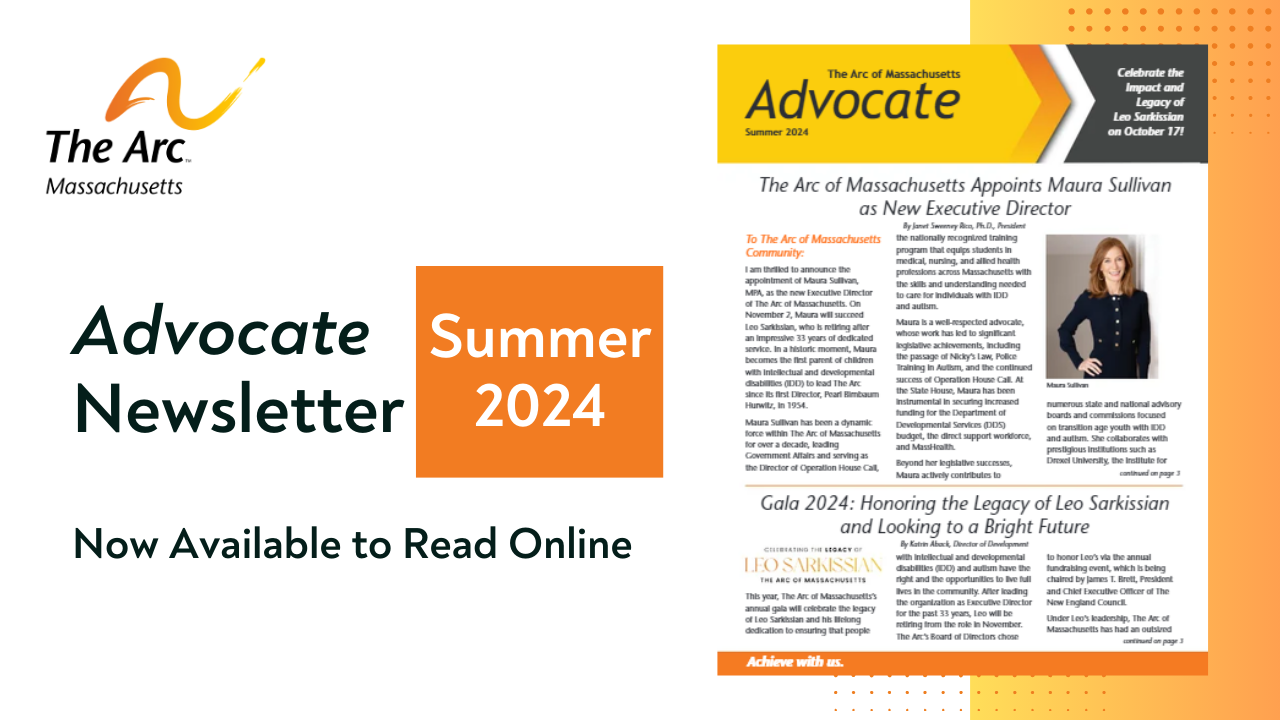The Summer 2024 issue of our print newsletter Advocate is now available to read online.
Highlights of the issue include:
- The announcement of Maura Sullivan’s appointment as the new CEO
- A closer look at an important, but not often discussed area of advocacy
- Articles on the importance of elections for the disability community
- The Kerry Mahoney Memorial Garden
- Recent activities from Operation House Call and Pathways to Friendship
- And much more
The Arc of Massachusetts Announces Appointment of Maura Sullivan as New Chief Executive Officer
The Arc of Massachusetts is pleased to announce the appointment of Maura Sullivan, MPA, as its new Chief Executive Officer, succeeding Executive Director Leo Sarkissian, who is retiring after 33 years of dedicated service. Sullivan will be the first parent of children with intellectual and developmental disabilities to lead The Arc since its first Director Pearl Hurwitz in 1954. She starts in the position on November 2.
Sullivan expressed her thoughts about the new role noting, “I am honored and humbled to lead The Arc of Massachusetts. Having children with disabilities, I understand the challenges families face firsthand. As CEO, I will work to build stronger partnerships to overcome the workforce crisis, eliminate archaic policies, and make advocacy a natural part of all our lives. There are incredible opportunities ahead for innovation and growth and The Arc is prepared to respond.” Learn more at thearcofmass.org/maura.
The Human Impact: Regulations, Regulatory Advocacy, and Access
By Leo Sarkissian
Too often we don’t share the work we do that has an impact on daily lives which is related to the management of services. The range of activities – legislative, administrative, judicial, federal, state, local, etc. – is hard to communicate, and few people would take the time to read it. There are three other reasons which make communication on regulatory advocacy difficult:
- The sheer time it takes to explain regulations and their impact. By their nature, regulations and policy take time to read and absorb.
- Discussions usually are behind the scenes and not known unless an issue becomes public, as in asking the legislature this year to prevent reductions to the personal care program.
- The discussion might be complicated, such as in the case of rates, when even a positive investment was misunderstood: the increase in direct care salary “median” pay didn’t mean all direct care was funded to reach a floor of $20 per hour.
Starting Social Inclusion Young
By Rachel Hayward
Younger generations seem to interact with technology as if it were second nature, something innate, but in reality, this adeptness comes from early and regular exposure. Kids grow up surrounded by smart phones, tablets, and apps, learning to use technology seamlessly and without a second thought. There is a need for this same practice of early and constant exposure and access when it comes to inclusion and developing friendships between people with and without disabilities.
One reason we need to work so hard to support friendships between adults with and without disabilities is that these groups were frequently segregated as children, never learning how to be with each other. If at an early age children of all abilities interact with each other and see adults with disabilities as role models and people of value, then inclusion and friendship can also become something they do seamlessly, without a second thought.
The Importance of Voting for the Disability Community
By Katerina Daley
Since 2018, The Arc of Massachusetts has been coordinating our voter rights campaign #TheArcVotes in order to share resources and stories about the importance of the disability vote. In each successive iteration of our non-partisan advocacy, the stakes associated with each election’s results for the disability community have only risen in our increasingly divided country.
According to the American Association of People with Disabilities in 2023, there are over 61 million people with disabilities in the country, and over 38 million of them are eligible to vote. Despite the size of this population, which makes it the largest minority voting bloc in America, voters with disabilities continue to vote at a lower rate than people without disabilities, largely due to barriers in place, such as inaccessible polling places, limitations on early or mail-in voting or drop-off boxes, or a lack of plain language in ballots.
From the 1990s to the 2020s: Similarities, Differences, and Progress
By Leo Sarkissian
Today, it’s hard to imagine the slowness in establishing home- and community-based services in the place of institutional care. It took 25 years to establish the change in the Commonwealth, let alone the country. In the FY1991 budget, the Department of Developmental Services (DDS, but not yet titled DDS then) continued to have a lopsided budget.
Despite most people with disabilities living in the community, the institution account totaled $293.86 million while the community account (including all adult community services except for transportation) totaled $253.23 million. $2 million was in what would become the Turning 22 account. Meanwhile, the right to education law (chapter 766) was decades old.




